"Everything that goes on in a match, you can do in a rondo. The competitive aspect, fighting to make space, what to do when in possession & what to do when you haven't got the ball, how to play 'one touch' soccer, how to counteract the tight marking & how to win the ball back." - Johan Cryuff
In recent years, teams like Barcelona, Bayern Munich and Manchester City have wowed supporters with their style of play, dominating the ball in the majority of their games. Of course they have had the same coach in common. They have also had a certain type of practice to help them achieve that - Rondos.
Contrary to popular belief, Rondos are a Dutch invention. They were taken to another level by Barcelona when they were coached by the late Johan Cryuff. Former World Cup winning midfielder Xavi highlights them as helping him to improve his decision-making ability, whether in space or not.
In recent years, certain governing bodies thoughts on Rondo's have been dismissive. The USSF for example, have been reported as actively discouraging them. Their mentality is that a Rondo is not directional. I couldn't disagree with this more. If performed correctly and with a little thought, there is no reason why we cannot transition a rondo into a game-related, directional practice. Starting with a rondo allows us to paint the pictures of team shape, off the ball movement, decision-making, areas of the field and when to play forward and when to retain the ball. These pictures are easily transferrable into our progressions.
Below we have 3 examples of rondos, covering the topics of turning possession into penetration, switching play and playing out of the back. Each rondo starts in it's basic form (keep away), progressing into a directional activity.
Possession into Penetration

3 v 1 is the most basic form of rondo and an ideal start for our younger foundation age groups. The limited players makes for clearer pictures on the field. Players can also gain an understanding of giving the player on the ball options to their left and right. However, the purpose of keeping the ball for the sake of it is a tough one for U8-U10 to understand if we take the way they view the game into account. We can progress this into the following activity
Progression 1
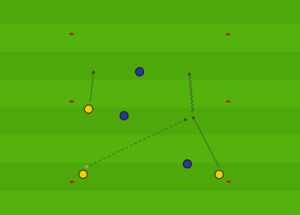
We start off with a 3 v 1 rondo in one half. In the opposing half are 2 additional players on the same team as the defender. If the defender wins the ball, they pass back to their team mates, join them and play 3 v 1 in their half.
If the team in possession are able to keep the ball for a designated period of time, a 2nd defender can enter, creating a 3v2. When the opportunity presents itself, they attempt to break in to the opposing half to score a point and start a new 3v1. This tweek allows us to paint the picture of keeping the ball to draw opponents in and create space to then penetrate.
Most coaches will set a designated amount of passes. I have done this in the past also. By doing this, you run the risk of players forcing a pass no matter what. Setting a time limit allows them to decide whether to pass or keep it themselves.
Progression 2
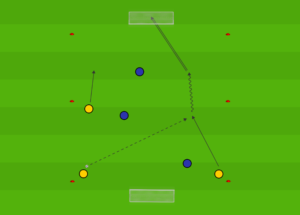
To go one step further, we add goals at either end of the playing area. When the team in possession break into the opposition half they can attempt to score, with one defender recovering. Both progressions are shown in the video below.
Depending on numbers you may have 2 teams of 4, allowing the picture of team shape to be painted if you coach a 5v5 team.
Switching Play
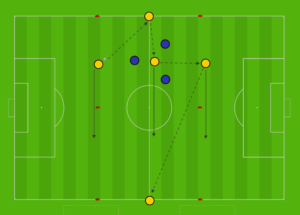
Switching Play requires the rondo to be split into 2 boxes. As you can see above, we are using the middle third of the field to help aid our progressions. We split this in half, with a 4v3 on the left hand side, and the additional attacking player standing as wide as possible on the right. In the starting playing area, 3 of the 4 attacking players are positioned on the perimeter of the playing area. The additional player has freedom to move in the middle (acting as the midfielder).
Every 5-10 seconds of possession, the attacking team look to switch the ball to the far side. If they achieve this, 3 players follow and support the receiving wide player. The 3 defenders switch sides as well. If the defenders win the ball, ask them to break out of the box they are in, rather than just kicking the ball away.
The number of players is not set, but maintain the overload in the favour of the attacking team.
Progression

To make the rondo directional, we use the goals. The team with the overload have a Goalkeeper to attack. The defending team are to counter attack the opposite goal when they win the ball. In front of each wide player is a coned gate for them to attack when the switch happens. They are not required to dribble through this. We want them to adopt this mentality to open up opportunities to exploit the middle if one defender reacts far quicker than the rest. 3 players attack the box, with all 3 defending players recovering.
This can be adopted for a lofted pass or a switch pass into the corner, depending on your mindset. The rondo allows players to see the importance of drawing opposition towards the ball to open up space on the far side.
Playing out of the Back
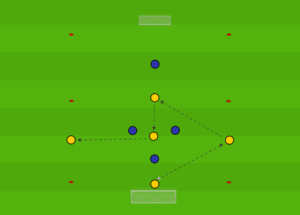
Our final rondo begins with a 6v3 overload (inc. GK). An additional defender man marks the player in the striker position. They can step in front to intercept passes if you wish, but to begin with just have them shadowing the striker. As with the previous activity, 4 players monitor a side of the playing area, with a free player in a central role. The GK can be used to help retain possession.
Players score a point by keeping the ball for a designated amount of time. They also score a point if they can split the defenders with a pass. The defenders can attack the goal if they win the ball.
This rondo is also good for players working on their transition reaction speed. Upon losing the ball, players may press the defending team to get the ball back and stop the shot. Upon winning the ball, it is important they open up and return to their starting positions to achieve success.
Progression
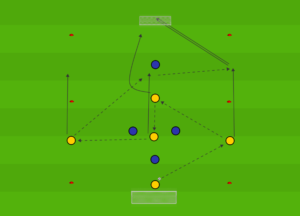
To progress and make it directional, we add a goal at the top of the additional part of the playing area. Upon scoring their point, the attacking team break into the next half and attempt to score.
In progressing the practice this way, we have built players confidence in keeping the ball in front of their own goal. Once this confidence is evident, we then start asking them to look for opportunities to penetrate the opposition. We are also able to paint the picture of the defence stepping up with the ball and not just hanging back by the goal. Players also learn the importance of changing the speed of their play.
So there we have it. 3 Rondos, all progressed to become directional and game-related. For coaches looking to play a possesion-based style of soccer, rondos provide an excellent tool to help your foundation age players understand the how, why, when and where of what you are after.
